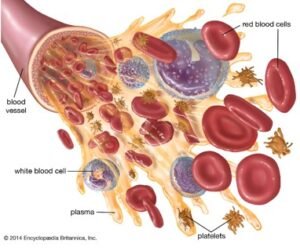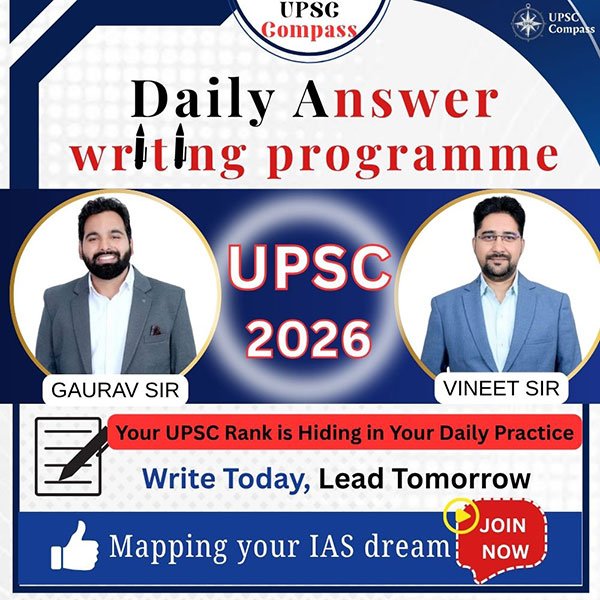
The Union Health Ministry is integrating the Rare Donor Registry of India (RDRI) with e-Rakt Kosh to enable real-time access to rare blood types (such as Bombay, Rh-null, P-Null) and improve nationwide coordination among blood banks.
Blood: Circulatory Fluid & Composition:
Blood is a specialized connective tissue that transports gases, nutrients, hormones, and waste throughout the body.
It consists of plasma (55%) and formed elements (45%), each with distinct physiological functions.
Plasma is ~92% water and contains proteins like albumin, globulin, and fibrinogen, along with electrolytes and nutrients.
Albumin regulates osmotic pressure, while globulins act in immune responses and fibrinogen aids clotting.
Plasma without clotting factors is called serum, used in diagnostics and therapy.
Formed Elements: RBCs, WBCs & Platelets:
RBCs (erythrocytes) are biconcave, enucleated cells in mammals, rich in haemoglobin for oxygen transport.
Each mm³ of blood contains about 5–5.5 million RBCs, with a lifespan of 120 days, destroyed in the spleen.
WBCs (leukocytes) are nucleated, immune cells, averaging 6,000–8,000/mm³, and classified as granulocytes or agranulocytes.
Neutrophils (60–65%) are phagocytes; eosinophils handle parasitic defense and basophils mediate inflammation via histamine.
Lymphocytes (20–25%) mediate adaptive immunity; B-cells produce antibodies and T-cells kill infected cells.
Platelets (thrombocytes) are cytoplasmic fragments from megakaryocytes, vital for clot formation and vascular repair.
Normal platelet count is 1.5–3.5 lakh/mm³; low levels cause excessive bleeding, high levels risk thrombosis.
Blood Clotting: Cascade & Enzymes:
Clotting is a cascade reaction triggered by injury, converting prothrombin to thrombin, which acts on fibrinogen.
Thrombin catalyzes formation of fibrin mesh, trapping cells to form a stable clot.
Thrombokinase, calcium ions, and clotting factors (I to XIII) regulate this process; most are inactive in plasma until needed.
Platelets and damaged tissues release activating factors, initiating the clotting mechanism.
Lymph: Tissue Fluid & Transport:
Tissue fluid, or interstitial fluid, forms when plasma filters through capillary walls into surrounding tissues.
This fluid carries nutrients and oxygen to cells and removes waste, maintaining fluid balance and cellular exchange.
Excess tissue fluid enters lymphatic capillaries, forming lymph, which drains into major veins via lymph nodes.
Lymph contains lymphocytes, crucial in immune responses, and also absorbs dietary fats via lacteals.
Blood Vessels: Pathways & Pressure:
Arteries carry oxygen-rich blood away from the heart, under high pressure; hence, they have thick muscular walls.
Veins return deoxygenated blood to the heart, have valves to prevent backflow, and thinner walls due to low pressure.
The pulmonary artery carries deoxygenated blood to lungs, and the pulmonary vein returns oxygenated blood to the heart.
Capillaries, the thinnest vessels, enable exchange of gases, nutrients, and waste at the tissue level.
ABO and Rh Blood Grouping: Genetics & Compatibility:
The ABO system is governed by the I gene, with three alleles: IA, IB, and i, leading to four phenotypes (A, B, AB, O).
IA and IB are co-dominant, while i is recessive; hence, six genotypes and four phenotypes exist.
Blood group O lacks both antigens and is a universal donor; group AB has both and is a universal recipient.
Plasma antibodies react with mismatched antigens, making cross-matching essential before transfusion.
Rh factor, similar to that in Rhesus monkeys, is present in 80–85% of humans; Rh⁺ individuals have it, Rh⁻ don’t.
Rh⁻ mother with Rh⁺ foetus may produce anti-Rh antibodies, leading to erythroblastosis foetalis in subsequent pregnancies.
This condition is preventable by administering anti-Rh immunoglobulin post-delivery of the first Rh⁺ child.
Rare Donor Registry of India (RDRI): National Initiative:
The Rare Donor Registry of India (RDRI) is a nationwide platform to identify and maintain records of donors with rare blood groups.
It was established by the ICMR-National Institute of Immunohaematology (NIIH) in partnership with premier medical institutions.
RDRI ensures availability of phenotype-matched blood for patients suffering from genetically linked blood disorders.
The registry supports long-term transfusion management for cases where standard ABO and Rh matches are insufficient.
e-Rakt Kosh: Digital Blood Bank Ecosystem:
e-Rakt Kosh is a centralised online portal that digitises the operations of all licensed blood banks across India.
It was developed by the Centre for Development of Advanced Computing (CDAC) under the National Health Mission.
The platform provides real-time inventory updates, including group-wise availability, volume, and expiry of blood units.
Hospitals and patients can search for nearby blood banks, book units, and locate donation camps easily.
रक्त:-
केंद्रीय स्वास्थ्य मंत्रालय दुर्लभ रक्त प्रकारों (जैसे बॉम्बे, आरएच-नल, पी-नल) तक वास्तविक समय में पहुंच को सक्षम करने और रक्त बैंकों के बीच राष्ट्रव्यापी समन्वय में सुधार करने के लिए भारत की दुर्लभ दाता रजिस्ट्री (आरडीआरआई) को ई-रक्त कोष के साथ एकीकृत कर रहा है।
रक्त: परिसंचारी तरल एवं संरचना:
रक्त एक विशिष्ट संजोजी ऊतक है जो शरीर में गैसों, पोषक तत्वों, हार्मोन और अपशिष्ट का परिवहन करता है।
यह प्लाज्मा (55%) और निर्मित तत्वों (45%) से मिलकर बना होता है, जिनका अलग-अलग शारीरिक कार्य होता है।
प्लाज्मा लगभग 92% जल से बना होता है और इसमें एल्बुमिन, ग्लोब्युलिन, और फाइब्रिनोजन जैसे प्रोटीन होते हैं।
एल्बुमिन परासरणीय दाब को नियंत्रित करता है, जबकि ग्लोब्युलिन प्रतिरक्षा प्रतिक्रिया में सहायक होते हैं और फाइब्रिनोजन थक्के में।
थक्का कारकों के बिना प्लाज्मा को सीरम कहा जाता है, जो निदान और चिकित्सा में प्रयोग होता है।
निर्मित तत्व: RBC, WBC एवं प्लेटलेट्स:
RBC (एरिथ्रोसाइट्स) द्विअवतल, नाभिक रहित कोशिकाएँ होती हैं जिनमें हीमोग्लोबिन होता है जो ऑक्सीजन को ले जाता है।
प्रत्येक mm³ रक्त में लगभग 5–5.5 मिलियन RBCs होते हैं और इनका जीवनकाल 120 दिन होता है; प्लीहा में नष्ट होते हैं।
WBC (ल्यूकोसाइट्स) नाभिकयुक्त, रंगहीन कोशिकाएँ होती हैं जो रक्षा करती हैं और सामान्यतः 6,000–8,000/mm³ पाई जाती हैं।
न्यूट्रोफिल्स (60–65%) फागोसाइटिक होते हैं; ईओसिनोफिल्स परजीवियों से लड़ते हैं और बेसोफिल्स सूजन में हिस्टामिन छोड़ते हैं।
लिम्फोसाइट्स (20–25%) अनुकूली प्रतिरक्षा में सहायक होते हैं; B-कोशिकाएँ एंटीबॉडी बनाती हैं और T-कोशिकाएँ संक्रमित कोशिकाओं को मारती हैं।
प्लेटलेट्स (थ्रोम्बोसाइट्स) मेगाकैरियोसाइट्स से उत्पन्न साइटोप्लाज्मिक खंड होते हैं जो थक्का बनाने में सहायक होते हैं।
सामान्य प्लेटलेट संख्या 1.5–3.5 लाख/mm³ होती है; कम होने पर रक्तस्राव, अधिक होने पर थ्रॉम्बोसिस का खतरा होता है।
रक्त का थक्काकरण: प्रक्रिया एवं एंजाइम:
थक्काकरण एक क्रमिक अभिक्रिया (कैस्केड) है जिसमें चोट लगने पर प्रोथ्रोम्बिन, थ्रोम्बिन में बदलता है जो फाइब्रिनोजन को फाइब्रिन में।
थ्रोम्बिन फाइब्रिन का जाल बनाता है जिसमें कोशिकाएँ फंसकर स्थिर थक्का (क्लॉट) बनाती हैं।
यह प्रक्रिया थ्रोम्बोकाइनेज़, कैल्शियम आयन, और थक्का कारकों (I-XIII) पर निर्भर करती है, जो प्लाज्मा में निष्क्रिय रूप में होते हैं।
प्लेटलेट्स और घायलों ऊतकों से निकले कारक इस प्रक्रिया को सक्रिय करते हैं।
लसीका: ऊतक द्रव एवं प्रतिरक्षा:
ऊतक द्रव तब बनता है जब प्लाज्मा केशिकाओं की दीवारों से बाहर निकलकर ऊतकों में जाता है।
यह द्रव पोषक तत्व एवं ऑक्सीजन कोशिकाओं तक पहुंचाता है तथा अपशिष्ट निकालता है, जिससे तरल संतुलन बना रहता है।
अतिरिक्त ऊतक द्रव लसीका वाहिनियों में प्रवेश कर लसीका बनाता है जो अंततः मुख्य शिराओं में वापस जाता है।
लसीका में लिम्फोसाइट्स होते हैं जो प्रतिरक्षा प्रतिक्रिया में प्रमुख होते हैं और इसमें लैक्टीअल्स के माध्यम से वसा का अवशोषण भी होता है।
रक्त वाहिकाएँ: मार्ग एवं दाब:
धमनियाँ उच्च दाब पर हृदय से ऑक्सीजन युक्त रक्त को बाहर ले जाती हैं और इनकी दीवारें मोटी और पेशीय होती हैं।
शिराएँ कम दाब पर हृदय की ओर रक्त को वापस लाती हैं, जिनमें वाल्व होते हैं और दीवारें पतली होती हैं।
फुफ्फुसीय धमनी हृदय से फेफड़ों को कार्बन डाइऑक्साइड युक्त रक्त ले जाती है और फुफ्फुसीय शिरा ऑक्सीजन युक्त रक्त वापस लाती है।
केशिकाएँ सबसे पतली होती हैं, और वहीं गैसों, पोषक तत्वों, और अपशिष्ट का विनिमय होता है।
ABO एवं Rh रक्त वर्गीकरण: अनुवांशिकी एवं संगतता:
ABO प्रणाली RBC की सतह पर A और B प्रतिजन की उपस्थिति पर आधारित होती है, जिसे I जीन नियंत्रित करता है।
IA और IB सहप्रभावी होते हैं, जबकि i अल्पप्रभावी होता है; इस कारण चार रक्त समूह बनते हैं (A, B, AB, O)।
O समूह में कोई प्रतिजन नहीं होता, इसलिए यह सर्वदाता कहलाता है; AB समूह में दोनों होते हैं, इसलिए यह सर्वग्राही होता है।
प्लाज्मा में उपस्थित प्रतिप्रतिजन यदि मेल नहीं खाते, तो RBC के जमने की समस्या हो सकती है।
Rh कारक, जो रीसस बंदरों में भी पाया जाता है, लगभग 80–85% मनुष्यों में उपस्थित होता है और वे Rh⁺ कहलाते हैं।
Rh⁻ व्यक्ति यदि Rh⁺ रक्त से संपर्क में आए तो एंटी-Rh एंटीबॉडी बना सकते हैं, जिससे अगली गर्भावस्था में एरिथ्रोब्लास्टोसिस फीटालिस हो सकता है।
इस स्थिति से बचाव के लिए Rh⁻ माँ को पहले Rh⁺ शिशु के जन्म के बाद एंटी-Rh इम्यूनोग्लोब्युलिन दिया जाता है।
भारत की दुर्लभ रक्तदाता पंजी (RDRI): राष्ट्रीय पहल:
भारत की दुर्लभ रक्तदाता पंजी (RDRI) एक राष्ट्रीय मंच है जो दुर्लभ रक्त समूह वाले दाताओं का रिकॉर्ड रखता है।
इसे ICMR-राष्ट्रीय इम्यूनोहेमेटोलॉजी संस्थान (NIIH) द्वारा प्रमुख चिकित्सा संस्थानों की साझेदारी में विकसित किया गया।
RDRI का उद्देश्य जीन-आधारित रक्त विकारों से पीड़ित मरीजों के लिए समान गुणसूत्रीय रक्त की उपलब्धता सुनिश्चित करना है।
यह पंजी ऐसे मरीजों को सहायता देता है जिन्हें ABO और Rh मिलान के अतिरिक्त अत्यधिक विशेष मिलान की आवश्यकता होती है।
ई-रक्त कोश: डिजिटल रक्त बैंक पारिस्थितिकी तंत्र:
ई-रक्त कोश एक केंद्रीकृत ऑनलाइन पोर्टल है जो भारत के सभी लाइसेंस प्राप्त रक्त बैंकों की कार्यप्रणाली को डिजिटाइज़ करता है।
इसे सी-डैक (CDAC) द्वारा राष्ट्रीय स्वास्थ्य मिशन के अंतर्गत विकसित किया गया है।
यह मंच वास्तविक समय पर भंडार अद्यतन देता है, जिसमें रक्त समूह, मात्रा और समाप्ति तिथि जैसी जानकारी होती है।
अस्पताल और मरीज निकटतम रक्त बैंक खोज सकते हैं, यूनिट बुक कर सकते हैं और दान शिविरों का पता लगा सकते हैं।




